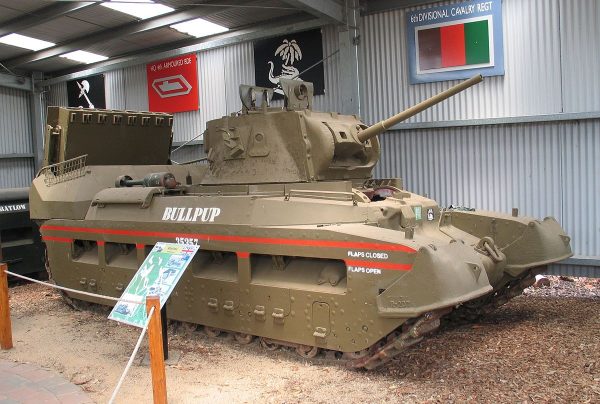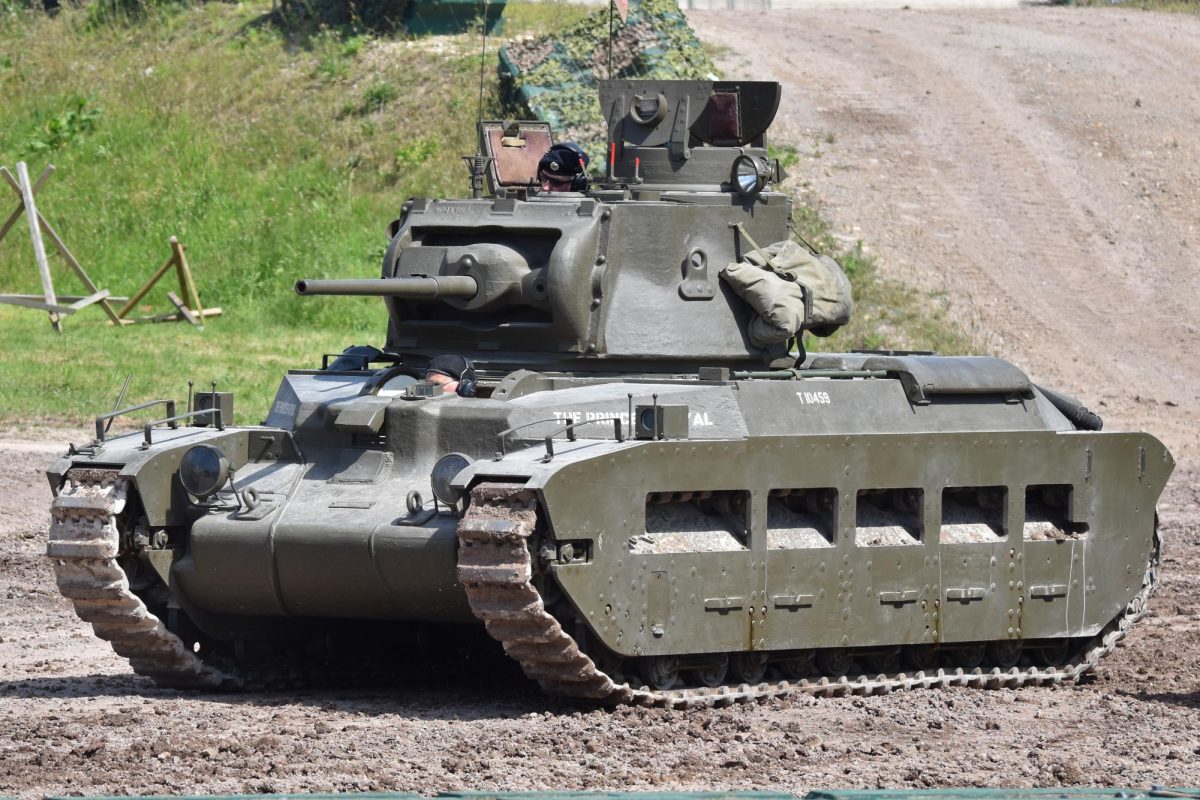The first tank to be made under the new tank doctrine of the British was the Matilda. This was an infantry tank that would be marketed at the British and Commonwealth governments only. The Matilda I was essentially useless with only a machine gun as its main armament, because it was meant to be a tank for supporting infantry, so the designers did not see the use of a cannon. This turned out to not be enough firepower for supporting significant infantry operations. That necessity for more firepower led to the Matilda II.
Unlike its predecessor, the Matilda II was an amazing design. It boasted a QF-2 40mm gun and one 7.92 Besa machine gun. It had some of the best armour of the day, with some parts even having 78 mm of cast armor, which was enough to stop even the German 88 mm flak AT guns that could reliably destroy any tank of that time. The vehicle had a crew of four, including a commander, a gunner, a driver, and a machine gunner. It could travel at 24 km/h on road and 14 km/h off-road. The tank was only received by late 1939, but was present in large enough numbers by the time of the battle for Egypt and El-Alamein. While serving in Africa, it gained the title “queen of the desert” due to its outstanding performance against the elements. Its armor proved to be too thick for most standard Axis AT-guns to penetrate, as well as significantly difficult for most Axis tanks to attack. Even the later Panzer models, such as the Panzer III-J, still had difficulties. The Matilda’s HE shell was almost unmatched in reliability, though it lacked about 10 grams of explosive filler compared to its German and Italian counterparts; still, it was comparatively better, due to its accuracy and aforementioned reliability. Its AP shell did leave much to be desired, however. It was a solid-shot AP, which meant its only crew damage was caused through direct contact, spalling, or hitting a vital component of the tank such as the ammo rack, fuel tank, or engine block. This hampered, but did not ruin, its anti-tank performance. After all, the tank was supposed to be hitting infantry, and still had one of the best AT guns for the period. Most infantry units spoke highly of the tank, with its only real issue being some mechanical issues serving in the desert. These were fixed with modifications and post-1942 variants.
The most noticeable variant of the Matilda is the Matilda II Mk. VI Close Support (CS). (Catchy name, right?) This version replaced the 40mm gun with a 76mm howitzer, which could only use HE or smoke shells, but was extremely effective against non-armored targets like infantry, motorized infantry, or even mechanized units. The CS model saw its largest use by the Australian Army via a lend-lease of around 409 Matildas, with the majority suspected to be CS models that were used in the Pacific. They were used by the Australians on every front they fought on, the most famous being the fighting in Indonesia and Papua New Guinea. This vehicle would be useful right up until the end of the war and even beyond. There is even a story about German Panzer IVs in the Netherlands in late 1944 or early 1945 not being able to penetrate two Matildas, which almost stopped a ten-tank German offensive in its tracks before retreating due to the overwhelming odds against them. It was used by almost all of the British dominions during the war, as well as the Soviet Union.
By the latter parts of the war, the Matilda II Mk. VI Close Support began to fall out of favor, due to the large number of more modern infantry tanks like the Churchill. This is why many were sent to reinforce the dominions and the Soviets, because they were plentiful and obsolescent. The Matilda II Mk. VI Close Support’s last use in combat was in 1948, with the Egyptian army during the 1948 Arab-Israeli War. During decolonization in Egypt, the Brits left a number of Matildas, which were then used against the Israelis. The tank’s service with the British, and most of the world, ended in 1955 when all remaining Matildas were decommissioned. Some were put in museums; most of them, sadly, were used as target practice for British tankers and AT-gunners.
Here is where I would normally move on to the next tank, but some of the things done to this tank in the form of variants are too wacky not to be mentioned.
- The Australians made the Matilda Frog, the Murray, and Murray FT. This was equipped with a coaxial flamethrower; the only difference between the Frog and Murray was that the fuel storage tank was larger on the Murray. These were used to clear bunkers and tight areas, as well as just being used if the enemy was close enough to support infantry in the Pacific Theater.
- Whoever made this next variant should be put in a mental institution and, simultaneously, be given the highest commendation possible in the Australian Army. This is the Matilda Hedgehog. This was a Matilda with a seven-chambered spigot mortar attached to the back of the vehicle. This proved useful, as it allowed mortar systems to keep up with the infantry in case it was necessary . . . but still, this thing is insane, right? It had some slight issues, such as the fact that firing the fifth tube required moving the turret so the shot would not hit the radio or antenna, and the tank’s direction automatically aimed the x-axis of the mortar, which somewhat damaged its accuracy. This was also meant to be a bunker and emplacement-busting weapon. Tests showed that if it hit, it definitely would have done its job, because the shell it fired had a 16-kg explosive warhead. Sadly, it never saw the light of day, since testing concluded in 1945 and the war ended before it could be used.

- The next weird variant was the Matilda Dozer. This had a dozer blade on the front that could be lowered and raised. There were other dozer tanks, such as the American M3 Dozer. Dozers on tanks are used to move earth, to make an emplacement for the tank, or to help in making defenses and emplacement for infantry and other forces. These proved quite useful in the battle for North Africa. They were used to make hull-down positions for tanks to defend, providing the defenders with the edge in repelling armored and non-armoured forces alike.
- One thing worth mentioning, but not important enough to go into depth with, was the Matilda Scorpion. It was a regular Matilda equipped with a mine flail. This last modification comes from the wacky guys in the Soviet Union. A number of Matildas had been sent to the Soviets throughout the war to help supply their defense. This was because the Eastern Front diverted a huge number of Axis forces, allowing for the Allied offensives and defenses to be plausible. This one has no official name, as it was a field modification, but how someone does this in the field, I have no idea. [Ed. Note—Very carefully.] This is a Matilda that had been modified in the field to replace the main armament with a Zis-5 76mm cannon. This essentially made it a heavy tank destroyer, completely going against the idea for the tank in the first place . . . but it still worked quite well.
In the next article, we will begin go beyond the tank for a moment and talk about some early tank destroyers, SPGs, and even a land battleship, before we continue with more British armoured shenanigans.
This article contains information from the British National Archives and Imperial War Museum. Pictures from the Australian War Memorial and The Tank Museum, Bovington.

russell montgomery • May 10, 2024 at 7:44 am
A couple of things. The 88mm creamed Matilda’s at Arras and in North Africa, every time they hit. Crew was Commander, Gunner, RadioOp/loader and driver there was no machine gunner. Matilda HE was poor but AP Shot was good. Australia’s Matilda’s were not mostly C/S. Pretty sure there were no Matilda’s in the Netherlands as fighting vehicles in 1944, and a Panzer IVs 75mm L/48 would penetrate Matilda armour easily. The Murray system was experimental, only the Frog was used. Why is a dozer variant weird? The US had no M3 dozer but did have an M4 dozer. Not sure if you are saying Matilda dozer were used in North Africa or not, but they weren’t. The Matilda dozer was not very successful and only used a few times in the pacific. Australia’s Matilda’s were new build, as were Russia’s, not used and worn out. Matilda’s were gone from British service by 1944 but used in Australia until 1955. Scorpion was used in North Africa and was not a Russian idea. Matilda’s were sent to Russia because they bought them, somewhere about 1000 got there. There was only one Zis 5 variant built, it worked well but there were insufficient guns and workshop space to carry out the conversion.
Carol Pethybridge • Jan 22, 2024 at 9:56 pm
I found the article interesting and entertaining.., especially the more quirky facts. Thanks for the in depth piece of writing James .
Sarah Pethybridge • Jan 22, 2024 at 9:31 pm
Very informative!!